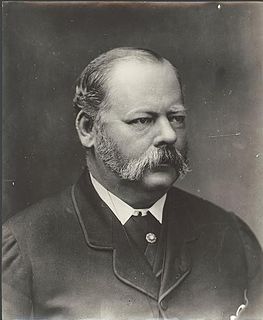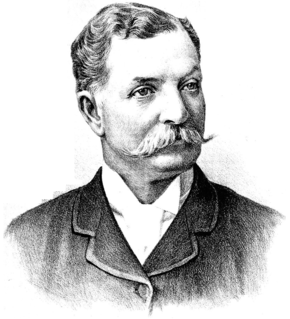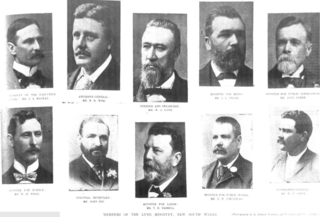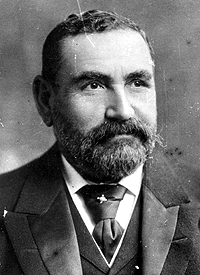Related Research Articles

Sir George Richard Dibbs KCMG was an Australian politician who was Premier of New South Wales on three occasions.

Sir Patrick Alfred Jennings, was an Irish-Australian politician and Premier of New South Wales.

Sir Francis Bathurst Suttor was an Australian pastoralist, politician, and sheep and horse breeder.
Sydney-Denison was an electoral district of the Legislative Assembly in the Australian state of New South Wales, created in 1894 from part of the electoral district of West Sydney in the Ultimo area and named after Governor Denison.

Murray is an electoral district in the Australian state of New South Wales.
Members of the New South Wales Legislative Assembly who served in the eighth parliament of New South Wales held their seats from 1874 to 1877.</ref> The 1874–75 election was held between 8 December 1874 and 12 January 1875 with parliament first meeting on 27 January 1875. There were 72 members elected for 52 single member electorates, 6 two member electorates and 2 four member electorates. During this parliament the number of graduates of Sydney University exceeded 100 and the seat of University of Sydney was created. The maximum term of this parliament was 3 years and the assembly was dissolved after 34 months. Premiers during this parliament were Sir John Robertson 9 February 1875 till 22 March 1877 and from 17 August 1877 and Sir Henry Parkes 22 March 1877 till 17 August 1877. The Speaker was William Arnold until his death on 1 March 1875 and then George Allen.
Ambrose George Enticknap was an Australian politician and a member of the New South Wales Legislative Assembly from 1941 until 1965. He was a member of the Labor Party and held numerous ministerial positions between 1950 and 1965.

The fifth Parkes ministry was the 26th ministry of the Colony of New South Wales, and was led by the seventh Premier, Sir Henry Parkes. It was the fifth and final occasion that Parkes was Premier. The title of Premier was widely used to refer to the Leader of Government, but was not a formal position in the government until 1920. Instead the Premier was appointed to another portfolio, usually Colonial Secretary. Having served in the New South Wales Legislative Council between 1854 and 1856, Parkes was elected in the first free elections for the New South Wales Legislative Assembly held in 1856, however resigned from Parliament later that year. He served in the Assembly on several occasions, between 1858 and 1870, being forced to resign on 4 occasions due to his personal insolvency. He came to power as Premier on the first occasion in 1872, serving as Premier for a period of three years. However, Parkes lost the confidence of the Assembly following Governor Robinson's decision to release of the bushranger Frank Gardiner led to the defeat of the ministry in 1875.

The third Dibbs ministry, the 27th ministry of the Colony of New South Wales, was led by Sir George Dibbs, leader of the Protectionist Party, following the 1891 New South Wales election, which saw the Labour Party win seats in the New South Wales Legislative Assembly and the balance of power. With no party having a majority, Sir Henry Parkes held on as Premier until October 1891 when he lost a vote in the Legislative Assembly, causing Parkes to resign as Premier and leader of the Free Trade Party. Dibbs formed the ministry on 23 October 1891, with Labour support, and comprised 10 ministers.

The Lyne ministry was the 29th ministry of the Colony of New South Wales, and was led by the 13th Premier, Sir William Lyne, KCMG.

The See ministry was the 30th ministry of the New South Wales Government, and was led by the 14th Premier, Sir John See. The title of Premier was widely used to refer to the Leader of Government, but was not a formal position in the government until 1920. Instead the Premier was appointed to another portfolio, usually Colonial Secretary.

Sir Robert Wisdom, was a politician in colonial New South Wales and Attorney General of New South Wales.

John Fitzgerald Burns was an Australian politician, member of the Parliament of New South Wales, Postmaster-General in the 1870s and Colonial Treasurer in the 1880s.

Walter Hussey Vivian was an Australian politician.

Charles Gilbert Heydon was an Australian politician and judge.
A by-election for the seat of Canterbury in the New South Wales Legislative Assembly was held on 10 October 1914. The by-election was triggered by the bankruptcy of Henry Peters (Labor).
A by-election was held for the New South Wales Legislative Assembly electorate of East Sydney on 11 January 1883 because George Reid was appointed Minister of Public Instruction in the Stuart ministry. Such ministerial by-elections were usually uncontested and six ministers were re-elected unopposed. On this occasion a poll was required in East Sydney and Newtown. Copeland was defeated but regained a seat in parliament at the second by-election for East Sydney held on 23 January 1883. The six other ministers, Alexander Stuart (Illawarra), George Dibbs, Henry Cohen, James Farnell, Francis Wright (Redfern) and Joseph Abbott (Gunnedah), were re-elected unopposed.
A by-election was held for the New South Wales Legislative Assembly electorate of East Sydney on 7 November 1891 because Edmund Barton (Protectionist) was appointed Attorney General in the third Dibbs ministry. Such ministerial by-elections were usually uncontested and the other seven other ministers, George Dibbs, Henry Copeland, John Kidd (Camden), William Lyne, John See (Grafton), Thomas Slattery (Boorowa) and Francis Suttor (Bathurst), were re-elected unopposed.
St Leonards, an electoral district of the Legislative Assembly in the Australian state of New South Wales was created in 1894 and abolished in 1904.
A by-election was held for the New South Wales Legislative Assembly electorate of South Sydney on 13 February 1893 because of the resignation of James Toohey (Protectionist), in protest at the failure of the Protectionist Dibbs government to implement principles of protection.
References
- 1 2 "Sir George Richard Dibbs (1834–1904)". Former Members of the Parliament of New South Wales . Retrieved 11 May 2019.
- ↑ "Examinations re Sir George Dibbs". The Sydney Morning Herald . 21 September 1893. p. 3. Retrieved 28 April 2021– via Trove.
- ↑ "In Bankruptcy: re George R Dibbs". New South Wales Government Gazette (213). 30 March 1893. p. 2632. Retrieved 28 April 2021– via Trove.
- ↑ "Writ of election: Murrumbidgee". New South Wales Government Gazette (201). 25 March 1893. p. 2509. Retrieved 28 April 2021– via Trove.
- ↑ Green, Antony. "1893 Murrumbidgee by-election". New South Wales Election Results 1856-2007. Parliament of New South Wales . Retrieved 28 April 2021.